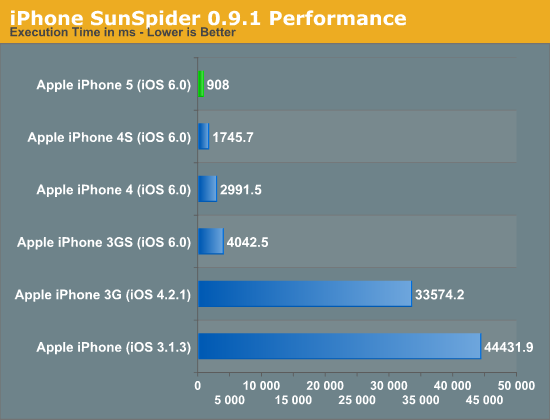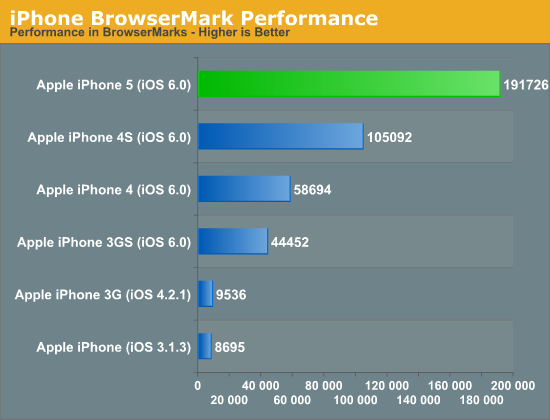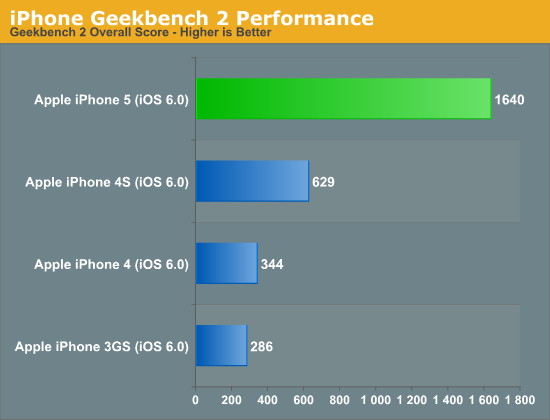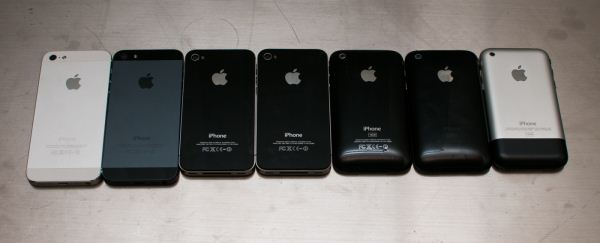The iPhone 5 Review
by Anand Lal Shimpi, Brian Klug & Vivek Gowri on October 16, 2012 11:33 AM EST- Posted in
- Smartphones
- Apple
- Mobile
- iPhone 5
Six Generations of iPhones: Performance Compared
Section by Anand Shimpi
Cross platform smartphone benchmarks are interesting, but they do come with their own sets of issues. Before we get to that analysis however, let's look at how the iPhone's performance has improved over the past six generations. Luckily Brian has a set of all of the iPhones so he was able to run a few tests on all of the devices, each running the latest supported OS.
We'll start with SunSpider 0.9.1, our trusty javascript performance test:

The transition from iPhone to iPhone 3G shows you just how much additional performance you can squeeze out of simply a software change. There's likely even more that could be squeezed out of that ARM11 platform, unfortunately newer versions of Safari/iOS aren't supported on the iPhone 3G so we're left with a runtime that's around 37x the length of a single run on the iPhone 5.
The rest of the devices support and run iOS 6, so we're at least on a level software playing field. The performance boost from one generation to the next is quite significant still. Going by this chart alone, the best balance of minimal upgrades and maximum perceived improvement would be from the original iPhone to the 3GS then again from the 3GS to the 5.

The BrowserMark results tell a similar story. The jump from the ARM11 based iPhone/iPhone 3G to the 3GS running iOS 6 is huge. Both the 4S and 5 offer doublings in performance, albeit for different reasons. The 4S delivered a doubling thanks to a doubling of core count and a move to the Cortex A9, while the iPhone 5 doubled performance through a much higher clock speed and microarchitectural improvements.
Finally we have Geekbench 2, which only runs on the iOS 6 supported devices so we say goodbye to the original iPhone and iPhone 3G:

None of the jumps looks as dramatic as the move to the iPhone 5, but we already know why. The Swift CPU architecture does a great job improving memory performance, which shows up quite nicely in a lot of the Geekbench 2 subtests.
On the PC side we often talk about 20% performance improvements from one generation to the next being significant. It's clear that the mobile SoC space is still operating along a hyper Moore's Law curve. The rate of progress will eventually slow down, but I don't see that happening for at least another couple generations. The move to ARM's Cortex A15 will be met with another increase in performance (and a similarly large set of power challenges), and whatever comes next will push smartphones into a completely new category of performance.












276 Comments
View All Comments
medi01 - Wednesday, October 17, 2012 - link
Try to do it in a darker environment.If you still don't notice that AMOLED black is actually, cough, black and "iphone"'s black is actually gray, you probably should visit a doctor.
darwiniandude - Friday, October 19, 2012 - link
Who cares about black being 100% black when all the colour accuracy is terrible? The galaxy note looks like is has cellophane over the screen next to an iPhone, the white doesn't look white. You take a photo of a hill side and all the trees and grass is the same over saturated shade of green. It's because of this that I'd only consider the HTC one X excuse it has an accurate LCD. I've personally never found an Amoled screen so far I can put up with. Each to their own, if black is more important to you than the rest of the spectrum, then enjoy it.bpear96 - Thursday, October 18, 2012 - link
Well obiously, there PPI's are almost the same, because of the size difference.If you had a 4.8" 1136 x 640 display, next to a 4" 1136 x 640 the 4.8" would not look nearly as good as the 4" because it would have a lower PPI (pixels per inch) since the GS3 is larger it needs a higher res display to be on par with the 4" iphone 5 display.
bpear96 - Thursday, October 18, 2012 - link
type - obviously *star-affinity - Tuesday, October 23, 2012 - link
The difference (in my opinion) being that the Galaxy S III has over saturated colors which is quite bad.http://www.displaymate.com/Smartphone_ShootOut_2.h...
GabeA - Saturday, January 5, 2013 - link
Sorry, you're comparing a poor screen technology (PenTile subpel matrix) with a top-of-the-line LCD. The comparison is flawed because the effective resolution on text is only ~82% in either direction (something like 1050 x 590 on sharp, black text) due to the interpolated, non-RGB subpixels.A good comparison would absolutely involve the One X series by HTC. In fact, holding the SGS3 and the One X side by side on this page shows an obvious difference in text clarity in favor of the One X.
rocketbuddha - Tuesday, October 16, 2012 - link
Don't you know that every iPhone comes with the halo of the RDF (Reality Distortion Field) :DThus things that other things have been having for months/years in other models appear antiquated/vanish once iPhone comes near ;-)
doobydoo - Friday, October 19, 2012 - link
So having the fastest hardware in any smartphone ever, the iPhone 5 was late to the party?Or was it the fact that it's the thinnest that you're claiming they copied from Android. Or lightest, or thinnest, or shortest, or battery life.
I wonder when any Android phone (bar the Razr Maxx which lets face it is a brick) will catch up?
A5 - Tuesday, October 16, 2012 - link
So you want a Droid Razr HD Maxx, then?webmastir - Tuesday, October 16, 2012 - link
Yep. That should be the #1 choice at the moment.